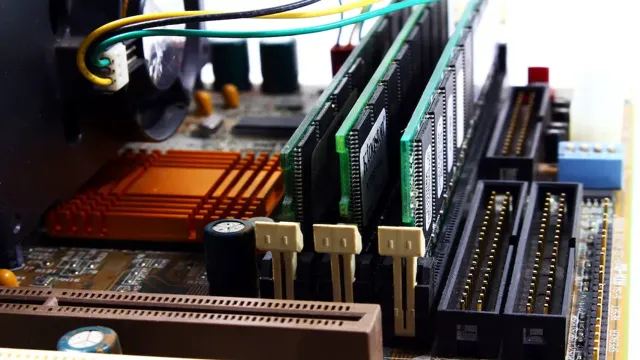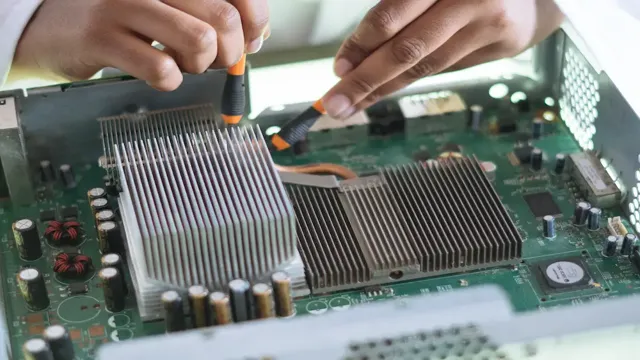Do you want to build your own PC, but don’t know where to start? One of the first steps is connecting the power button to your motherboard. While it may seem intimidating at first, it’s actually a simple process that anyone can do with the right guidance. Think of it like connecting your phone charger to a socket – once you know how to do it, it’s a piece of cake.
In this blog post, we’ll walk you through the steps to connect your power button to your motherboard. We’ll cover the tools you’ll need, the types of connectors you’ll come across, and how to locate the correct pins. With our step-by-step guide, you will be able to turn on your PC with ease.
Whether you’re a seasoned builder or a first-timer, it’s important to understand the basics of connecting your power button to your motherboard. Not only will it allow you to turn on your PC, but it also ensures that the motherboard and power supply are functioning properly. So let’s dive in and learn how to connect your power button to your motherboard!
Check Your Motherboard Manual
Connecting the power button to the motherboard is a crucial step in building a computer. However, it can be confusing for those who are new to building PCs. To get it right, the first thing you should do is check your motherboard manual.
Every motherboard has different pins labeled differently, which may be confusing to first-time builders. The motherboard manual provides you with the necessary information needed to connect the power button correctly. On most motherboards, the pins are located on the bottom-right side and are labeled power switch, reset switch, power LED, and HDD LED.
It’s important to connect these pins correctly to avoid any damage to the motherboard or components. Remember to take your time and double-check the manual to connect the power button accurately. With a little bit of patience and attention to detail, connecting the power button to the motherboard will be a breeze.
Locate the Power Header on the Motherboard
If you’re building your own PC, you’ll need to know where to locate the power header on the motherboard. This is where you’ll plug in the power switch, reset switch, and LED lights that indicate the status of your system. The first step is to check your motherboard manual, which will have a detailed diagram showing you where the power header is located.
It’s usually near the bottom edge of the board, close to the front panel connectors. Some motherboards also have a separate header for the power supply’s 4 or 6-pin CPU power cable. Make sure to refer to the manual for any details about the layout and orientation of the power header pins, as they can vary depending on the motherboard manufacturer.
By finding and correctly connecting the power header, you’ll be one step closer to powering up your new PC build.

Identify the Power Button Connector
One essential component of building a computer is identifying the power button connector on your motherboard. It’s a vital connection because without it, you won’t be able to turn on your computer. Your motherboard manual should have a diagram that shows the location of the power button connector.
It’s usually located near the front panel header. Some newer models of motherboards make it easier to identify power button connectors by having labeled pins that correspond to the power connectors from your case. If you can’t locate your motherboard manual, you can always find a digital copy of it online.
It’s crucial to make sure you correctly identify the power button connector to avoid any mistakes that could damage your motherboard or even your entire system.
Connect the Power Button to the Motherboard Header
Connecting the power button to the motherboard header is a crucial step in building your PC. It’s what turns your computer on and off! To connect the power button, first, locate the header on the motherboard, usually located in the bottom-right corner. Then, identify the two pins that are labeled as the power switch pins.
With a screwdriver or your fingers, gently place the power button connector onto these pins. Make sure the connector is tightly secured onto both pins, and you’re good to go! Once you complete this step, you can connect the rest of your computer components and power up your new machine. Don’t forget to double-check your connection to ensure that everything is properly connected before booting up your system.
With this straightforward process, you’ll be able to connect your power button to your motherboard like a pro!
Insert the Power Button Connector into the Header
When it comes to building your PC, connecting the power button to the motherboard header is a necessary step to ensure your system is fully functional. To do this, locate the power button connector on your computer case and carefully insert it into the matching header on the motherboard. This connection allows you to turn your PC on or off with just a simple push of a button.
It’s important to be gentle and ensure the connector is fully in place to avoid any damage or misalignment. Once properly connected, you can power up your new PC and start exploring all it has to offer. So, don’t forget to connect the power button to the motherboard header and take the first step towards a fully functional system.
Confirm the Connection
One important step after installing the power button on your computer case is to connect it to the motherboard header properly. You want to make sure the power button is connected to the correct pins on the motherboard to avoid any functionality issues down the line. Before doing anything, make sure to double-check your motherboard’s manual to locate the power header.
This header will typically be labeled as “PWR_SW” or “POWER SW”. Once you have identified the header, align the power button’s connector with the corresponding pins on the header, and then gently press it in place. With the power button now connected, you can confirm the connection by pressing the button and checking if your computer powers on.
If everything works as expected, congratulations! You have successfully connected your power button to the motherboard header.
Replace the Computer Case Cover
If you’re building or upgrading a computer, you’ll need to connect the power button to the motherboard header to make it work. It may sound intimidating, but with a little patience and knowledge, it’s a relatively simple process. First, locate the motherboard header where the power button will connect.
It’s usually labeled as something like “PWR_SW” or “POWER”. Then, refer to the motherboard manual or the documentation that came with your case, and find the corresponding pins for the power button. The pins are usually located in a 2-pin or 3-pin configuration.
Plug the pins from the power button into the header, making sure that they are securely in place. Finally, test the power button to ensure that it turns on your computer. Congratulations, you’ve successfully connected the power button to the motherboard header!
Test the Power Button Connection
Connecting the power button to your motherboard may seem like a daunting task, but it is actually quite simple. The power button is used to turn your computer on and off, and it is usually located on the front of your computer case. To connect it to the motherboard, you will need to locate the pins on your motherboard that are labeled for the power button.
These pins are usually located near the bottom of the motherboard, along with other pins for the reset button, speaker, and other functions. You will then need to connect the power button cable to the pins using the small connectors that are included with your motherboard. Make sure to consult your motherboard manual for specific instructions on where to connect the power button cable.
Once you have connected the power button, you should test it to make sure it is working properly. Simply press the button and see if your computer turns on. If it does, congratulations! You have successfully connected the power button to your motherboard.
Power On the Computer
When you power on your computer, it’s important to ensure that the power button is properly connected. This is especially true if you’ve recently built or upgraded your PC. Sometimes, the power button can become loose or disconnected, which can prevent your computer from turning on.
To test the connection, you can simply press the power button and see if the computer starts up. If it doesn’t, you may need to check the wiring and connections inside the computer. It’s also a good idea to check your motherboard manual or online guides to ensure that the power button is properly connected to the correct pins on the motherboard.
By taking these simple steps, you can ensure that your computer will start up smoothly and reliably every time.
Verify the Power Button Functions Properly
When it comes to the power button on your device, it’s important to ensure that everything is working properly. Testing the power button connection is a simple yet effective way to verify that your device is in good working order. To do this, simply press the power button and see if your device turns on.
If it doesn’t turn on, there may be an issue with the button itself, or it could be a more serious problem with your device. Checking the power button connection can also be useful if you’re experiencing issues with your device randomly powering off or restarting. In order to keep your device running smoothly, it’s important to regularly perform simple checks like this to make sure everything is in good working order.
By keeping an eye on your device’s power button connection, you can catch any issues early on before they become bigger problems. So, take a moment to test your power button connection and ensure that everything is working as it should be.
Conclusion
In conclusion, connecting the power button to the motherboard may seem daunting at first, but fear not – it’s actually quite simple! Just locate the two pins labeled “power SW” on your motherboard and connect the corresponding cables from the power button. And if all else fails, just remember the timeless advice of Douglas Adams: “Don’t panic!” With a little patience and a steady hand, you’ll have your power button up and running in no time. Happy computing!”
FAQs
What is the purpose of connecting the power button to the motherboard?
Connecting the power button to the motherboard allows you to turn on and off your computer.
Where can I find the power button connector on the motherboard?
The power button connector is typically located near the front panel connectors on the motherboard.
What happens if I accidentally connect the power button to the wrong pins on the motherboard?
If you connect the power button to the wrong pins, your computer may not turn on or may experience other issues.
How do I know which pins to connect the power button to on the motherboard?
The motherboard manual should have a diagram or instructions on which pins to use for the power button connector.
